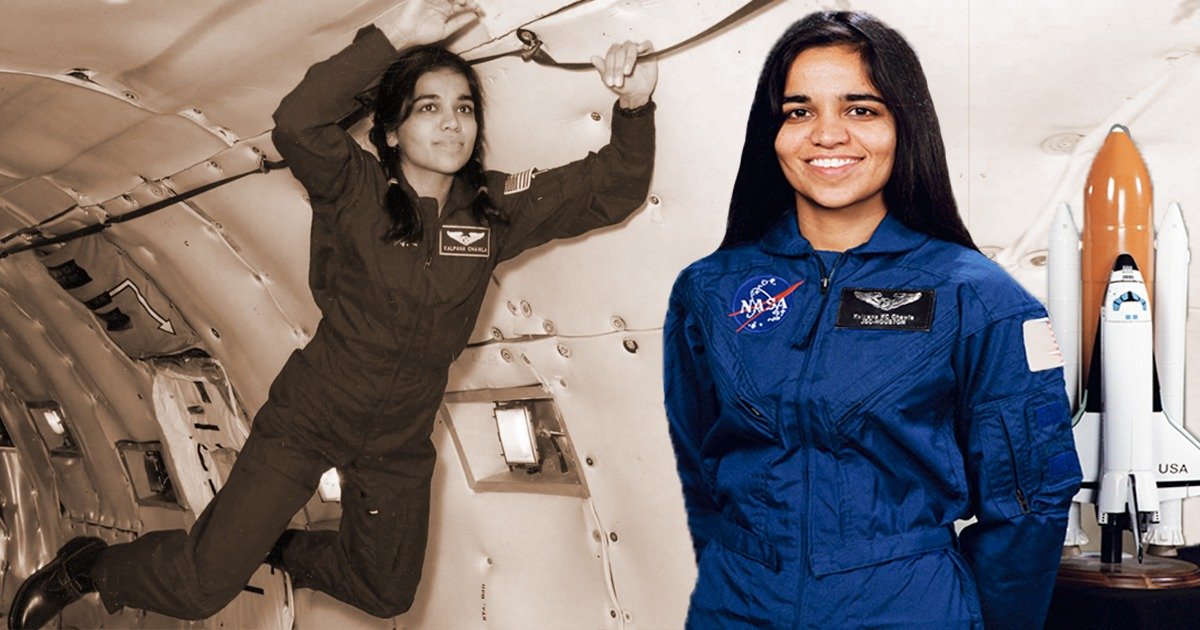Kalpana Chawla, an iconic figure in space exploration, captured the imagination of millions with her remarkable achievements and enduring legacy. Born in India, Chawla made history as the first Indian-born woman in space. Her contributions to space science and her inspiring life story continue to resonate with people worldwide. This blog post explores the life of Kalpana Chawla, her space missions, her tragic end, and the impact she left on future generations.
Early Life and Education of Kalpana Chawla
Kalpana Chawla was born on July 1, 1961, in Karnal, Haryana, India. From a young age, she demonstrated a keen interest in flying and space. Her fascination with aviation began when she was a child, inspired by the stories of astronauts and the vastness of space. Chawla pursued her undergraduate studies in Aeronautical Engineering at Punjab Engineering College, Chandigarh. She later moved to the United States for her higher education, obtaining a Master’s degree in Aerospace Engineering from the University of Texas at Arlington.
Chawla’s passion for space was evident throughout her academic career. Her commitment to aerospace engineering was fueled by a desire to contribute to space exploration. After completing her Master’s degree, she continued her studies and earned a Ph.D. in Aerospace Engineering from the University of Colorado Boulder. Her doctoral research focused on the dynamics of spacecraft and contributed to the field of space science.
Kalpana Chawla’s Career at NASA: Breaking Barriers
Kalpana Chawla’s journey to NASA was marked by perseverance and dedication. She joined NASA in 1988, initially working at the Ames Research Center. Her work focused on computational fluid dynamics and the study of space vehicle design. In 1994, Chawla was selected as an astronaut candidate by NASA, a significant milestone in her career.
Her first space mission was aboard the Space Shuttle Columbia on STS-87 in 1997. During this mission, she conducted experiments in space and contributed to various scientific studies. Chawla’s performance on this mission established her as a prominent astronaut. Her work involved experiments in fluid dynamics and material science, which were crucial for understanding the effects of microgravity on different substances.
Chawla’s second space mission, STS-107, was also aboard the Space Shuttle Columbia. This mission, which began on January 16, 2003, aimed to conduct a wide range of scientific experiments. Unfortunately, the mission ended in tragedy when the shuttle disintegrated upon re-entry into Earth’s atmosphere on February 1, 2003. The disaster was caused by damage sustained during launch, leading to the shuttle’s catastrophic failure.
Achievements and Awards: Celebrating Kalpana Chawla’s Success
Kalpana Chawla’s achievements extended beyond her missions in space. She was honored with several awards and recognitions for her contributions to space science and her pioneering spirit. Among the accolades were the NASA Space Flight Medal and the Congressional Space Medal of Honor. Her legacy is celebrated through various memorials and tributes, including educational institutions named in her honor and awards established to inspire future generations.
The NASA Space Flight Medal was awarded to Chawla for her contributions to space missions and her exemplary performance as an astronaut. The Congressional Space Medal of Honor, one of the highest honors awarded to astronauts, was presented posthumously in recognition of her bravery and dedication to space exploration.
Chawla’s impact is also commemorated through the naming of various institutions and awards. The Kalpana Chawla Memorial Trust, established in her honor, provides scholarships and support for students pursuing careers in science and engineering. Her achievements continue to be celebrated through educational programs, memorials, and cultural references.
Kalpana Chawla’s Space Missions: A Detailed Overview
Chawla’s space missions were groundbreaking and showcased her dedication to advancing space exploration. Her first mission on STS-87 was followed by her second mission on STS-107, which tragically ended in disaster. During STS-107, she conducted important research on microgravity and various scientific experiments.
The STS-87 mission, Chawla’s first spaceflight, involved conducting experiments in space that aimed to enhance our understanding of microgravity effects. The mission included a variety of scientific studies, including experiments in fluid dynamics, material science, and biological systems. Chawla’s work on this mission provided valuable insights that contributed to the advancement of space technology and research.
The STS-107 mission was intended to be a comprehensive research mission, with experiments designed to explore the effects of microgravity on various processes. Chawla and her crew conducted experiments in fields such as combustion, fluid dynamics, and biology. Unfortunately, the mission was cut short due to the shuttle disaster, which resulted in the loss of Chawla and her fellow astronauts.
The Challenger Disaster: How and When Kalpana Chawla Died
Kalpana Chawla’s second mission, STS-107, ended in tragedy when the Space Shuttle Columbia disintegrated upon re-entry into Earth’s atmosphere on February 1, 2003. The disaster resulted from damage sustained during launch, which led to the shuttle’s catastrophic failure. The loss of Kalpana Chawla and her six fellow astronauts was a devastating blow to the space community and the world.
The disaster was caused by a piece of foam insulation that broke off from the shuttle’s external tank during launch. This foam struck the shuttle’s left wing, causing damage that ultimately led to the shuttle’s disintegration upon re-entry. The investigation into the disaster revealed flaws in NASA’s safety procedures and prompted changes to improve the safety of future space missions.
What Happened to Kalpana in Space
During her space missions, Kalpana Chawla was involved in various scientific experiments and research. Her work on STS-107 included experiments on the effects of microgravity on combustion, fluid dynamics, and biological systems. Despite the tragic end of her final mission, her contributions to space science remain highly regarded.
The experiments conducted during STS-107 aimed to explore how microgravity affects different processes, such as the behavior of flames and the growth of plants. The data collected from these experiments provided valuable insights into the effects of space on various materials and processes, contributing to our understanding of space environments.
Does Kalpana Chawla Have a Child?
Kalpana Chawla did not have any children. She was married to Jean-Pierre Harrison, a businessman and flight instructor. The couple shared a deep bond, and Harrison has been a source of support in preserving Chawla’s legacy and advocating for space exploration. Their relationship was marked by mutual respect and shared passion for aviation and space science.
Who Went to Space After Kalpana Chawla?
Following Kalpana Chawla’s tragic death, space exploration continued to advance with numerous missions and astronauts carrying forward her legacy. Notable astronauts who followed in her footsteps include Sunita Williams, another Indian-American astronaut who has made significant contributions to space missions. The spirit of exploration and innovation continues to drive the space programs of various countries, inspired by pioneers like Chawla.
Sunita Williams, an accomplished astronaut, has carried forward Chawla’s legacy by contributing to space missions and promoting STEM education. Her achievements and contributions to space exploration serve as a testament to the impact of Kalpana Chawla’s pioneering work.
Kalpana Chawla’s Influence on STEM Education
Kalpana Chawla’s impact extends beyond her achievements in space. Her legacy has significantly influenced STEM (Science, Technology, Engineering, and Mathematics) education, particularly inspiring young girls and underrepresented groups to pursue careers in these fields. Educational institutions around the world have honored her memory by establishing scholarships, programs, and initiatives aimed at encouraging students to explore STEM disciplines.
One notable example is the Kalpana Chawla Memorial Scholarship, which supports students pursuing higher education in engineering and science. This scholarship is awarded to students who demonstrate exceptional academic achievement and a commitment to contributing to their fields. By providing financial assistance and recognition, the scholarship helps remove barriers to education and opens doors for talented individuals who might otherwise face challenges.
Furthermore, Chawla’s story has been integrated into school curriculums and educational programs. Her achievements are highlighted in textbooks, documentaries, and educational materials to serve as an inspirational example for students. Teachers often use her life as a case study to discuss the importance of perseverance, dedication, and the pursuit of one’s dreams. By presenting her story in educational settings, educators aim to inspire the next generation of scientists, engineers, and explorers.
Public and Private Tributes to Kalpana Chawla
Kalpana Chawla’s contributions to space exploration and her tragic death have led to numerous public and private tributes. These tributes serve not only as a way to honor her memory but also as a means of celebrating her achievements and the impact she made on the world.
One of the most significant public tributes is the naming of various institutions and facilities in her honor. For example, the Kalpana Chawla Space Technology Cell at the Indian Institute of Technology (IIT) in Mumbai is dedicated to advancing research in space technology. This facility supports cutting-edge research and development projects, helping to drive innovation in aerospace engineering.
In addition to educational institutions, several monuments and memorials have been established to commemorate Kalpana Chawla. The Kalpana Chawla Planetarium in her hometown of Karnal is a popular destination for visitors interested in space and astronomy. The planetarium offers educational programs, exhibits, and interactive displays that celebrate Chawla’s contributions to space science.
Private tributes also play a role in preserving her legacy. Family members, friends, and colleagues continue to celebrate her life through personal reflections, speeches, and events. These tributes often focus on Chawla’s character, her dedication to her work, and the impact she had on those around her. By sharing personal stories and memories, those who knew her keep her spirit alive and inspire others to follow in her footsteps.
Kalpana Chawla’s Impact on Space Research and Technology
Kalpana Chawla’s influence on space research and technology extends beyond her space missions. Her work has had a lasting impact on the field, contributing to advancements in spacecraft design and space mission strategies.
During her time at NASA, Chawla was involved in several critical projects that advanced our understanding of space and improved technology. Her expertise in computational fluid dynamics played a crucial role in refining the design of spacecraft. This research helped improve the safety and efficiency of space missions, influencing subsequent designs and technologies used in space exploration.
Chawla’s work on the Space Shuttle Columbia missions provided valuable data on how spacecraft perform under different conditions. Her experiments on STS-87 and STS-107 helped scientists gain insights into microgravity effects, which are essential for designing experiments and technologies that can be conducted in space. The knowledge gained from her work has been used to develop better materials, improve spacecraft performance, and enhance the safety of future missions.
Moreover, Chawla’s contributions to space research have inspired new generations of scientists and engineers to pursue careers in aerospace technology. Her work demonstrated the importance of rigorous research and the impact that dedicated scientists can have on advancing technology. The field of space exploration continues to benefit from the foundation laid by Chawla and her colleagues, driving innovation and progress in the quest to explore beyond our planet.
Kalpana Chawla’s Legacy in Popular Culture
Kalpana Chawla’s legacy extends into popular culture, where her life and achievements have been depicted in various forms of media. Her story has inspired numerous works, including books, documentaries, and films that celebrate her contributions to space exploration and her enduring influence.
One notable example is the biography “The First Woman in Space” by Om Gupta, which chronicles Chawla’s journey from her early life in India to her career at NASA. The book provides an in-depth look at her achievements and personal life, offering readers a comprehensive understanding of her impact on space exploration.
In addition to books, several documentaries have been produced to honor Chawla’s memory. These documentaries explore her life, missions, and the circumstances surrounding the Columbia disaster. They feature interviews with colleagues, family members, and experts who provide insights into Chawla’s contributions and the significance of her work.
Chawla’s story has also been portrayed in films and television shows, which highlight her role as a pioneering astronaut. These portrayals serve to inspire audiences and bring attention to the importance of diversity and representation in STEM fields. By sharing her story through popular media, her legacy continues to reach new audiences and motivate individuals to pursue their own dreams.
Educational Initiatives and Programs Named After Kalpana Chawla
Several educational initiatives and programs have been established in Kalpana Chawla’s name to honor her memory and continue her legacy. These programs aim to support and inspire students pursuing careers in science, technology, engineering, and mathematics (STEM).
One significant initiative is the Kalpana Chawla Space Technology Cell at the Indian Institute of Technology (IIT) in Mumbai. This facility is dedicated to advancing research in space technology and fostering innovation in aerospace engineering. The cell supports various research projects and provides resources for students and researchers interested in space exploration.
Another notable program is the Kalpana Chawla Memorial Scholarship, which offers financial assistance to students pursuing higher education in STEM fields. This scholarship is designed to support students who demonstrate exceptional academic achievement and a commitment to contributing to their fields. By providing financial support and recognition, the scholarship helps remove barriers to education and encourages talented individuals to pursue their goals.
In addition to these programs, several schools and universities have named facilities and awards after Kalpana Chawla. These tributes serve to honor her contributions to science and inspire students to follow in her footsteps. Educational institutions use her story as a source of motivation and a reminder of the importance of perseverance and dedication in achieving one’s goals.
Conclusion
Kalpana Chawla’s life and legacy continue to inspire and captivate the world. Her groundbreaking achievements as an astronaut, her impact on space research and technology, and her enduring influence on STEM education make her a remarkable figure in history. Through her work and dedication, Kalpana Chawla has left an indelible mark on space exploration and continues to inspire future generations of scientists and explorers.











